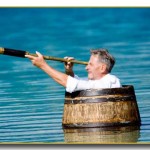Dante’s Bagpipes Redux
 Quick poll: How many pipers play piobaireachd by taking their instructor’s interpretation and/or following the Piobaireachd Society setting without question?
Quick poll: How many pipers play piobaireachd by taking their instructor’s interpretation and/or following the Piobaireachd Society setting without question?
One of the more interesting aspects you find on deeper study of ceol mor is the fact that the interpretations of the tunes are not fixed and have been expressed differently by just about every individual who has compiled or taught the tunes over the centuries. Heck, even the “Bobs” of Balmoral were known to depart here and there with the teachings of their tutor John MacDonald. What’s typically left unsaid is the true variability and “liberty,” if you will, every player can take with the music. But how do you do that when much piobaireachd teaching is perceived as dogmatic? In the Spring 2007 issue of the EUSPBA’s The Voice magazine I published an editorial that likened piping scholarship with Dante’s journey into the underworld.
“If you look at other fields of musical study, the available source material for research and information gathering are organized, accessible, and open for the most part. It is not a mystery where to find just about any information you might be seeking. But try to find a written example of one of the old pipe tunes, or try to access the available manuscripts of the great compilers and composers. I think Freemasons are more willing to give up their secrets.…”
My goodness how things have changed in just a few years! At this moment, anyone interested in studying piobaireachd and examining the source material for the settings we play today can download and/or peruse them all on their own at several websites. The Piobaireachd Society to their credit has done an amazing job of posting facsimiles of the manuscripts of the National Library of Scotland, most notably the Campbell Canntaireachd, the ms. of Neil MacLeod of Gesto, and the Colin Cameron collection.
Jim McGillivray over at Pipetunes.ca, who has leveraged the digital age for some time, also has up on his site the manuscripts of Angus MacKay, David Glen, Peter Reid, and the Nether Lorn Canntaireachd.
Every piper with an interest in piobaireachd should make it part of their study to click through these collections. A student of the music couldn’t ask for a more satisfying and eye-opening experience than to pour through these settings and compare them with what is being played today. (It is even more revealing to find actual mistakes and errors of fact in the “official” settings. [Why don’t they fix these things, he asked.])
At any rate, the true fluid nature of the interpretations in the tunes becomes evident. There is nothing big or earth-shattering here. Just small twists in phrasing or embellishment that can have a profound effect on the feel of a tune. No more excuses for players of piobaireachd to remain ignorant of the history and variety of the settings offered in the big music.
Do yourself a world of good and take whatever tune you are working on currently and find it in the old manuscripts. Study the differences between settings and experiment with them. Get a feel for the scansion brought out in the depiction of note groupings and understand perhaps how the current setting as presented to you by your teacher was derived…or change it to suite your taste. The music is yours.
 Pipehacker
Pipehacker







